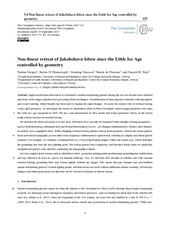| dc.contributor.author | Steiger, Nadine | |
| dc.contributor.author | Nisancioglu, Kerim H. | |
| dc.contributor.author | Åkesson, Henning | |
| dc.contributor.author | Fleurian, Basile de | |
| dc.contributor.author | Nick, Faezeh M. | |
| dc.date.accessioned | 2018-03-13T08:42:57Z | |
| dc.date.available | 2018-03-13T08:42:57Z | |
| dc.date.issued | 2017-09 | |
| dc.identifier.issn | 1994-0424 | en_US |
| dc.identifier.issn | 1994-0416 | en_US |
| dc.identifier.uri | https://hdl.handle.net/1956/17509 | |
| dc.description.abstract | Rapid acceleration and retreat of Greenland's marine-terminating glaciers during the last two decades have initiated questions on the trigger and processes governing observed changes. Destabilization of these glaciers coincides with atmosphere and ocean warming, which broadly has been used to explain the rapid changes. To assess the relative role of external forcing versus fjord geometry, we investigate the retreat of Jakobshavn Isbræ in West Greenland, where margin positions exist since the Little Ice Age maximum in 1850. We use a one-dimensional ice flow model and isolate geometric effects on the retreat using a linear increase in external forcing. We find that the observed retreat of 43 km from 1850 until 2014 can only be simulated when multiple forcing parameters – such as hydrofracturing, submarine melt and frontal buttressing by sea ice – are changed simultaneously. Surface mass balance, in contrast, has a negligible effect. While changing external forcing initiates retreat, fjord geometry controls the retreat pattern. Basal and lateral topography govern shifts from temporary stabilization to rapid retreat, resulting in a highly non-linear glacier response. For example, we simulate a disintegration of a 15 km long floating tongue within one model year, which dislodges the grounding line onto the next pinning point. The retreat pattern loses complexity and becomes linear when we artificially straighten the glacier walls and bed, confirming the topographic controls. For real complex fjord systems such as Jakobshavn Isbræ, geometric pinning points predetermine grounding line stabilization and may therefore be used as a proxy for moraine build-up. Also, we find that after decades of stability and with constant external forcing, grounding lines may retreat rapidly without any trigger. This means that past changes may precondition marine-terminating glaciers to reach tipping-points, and that retreat can occur without additional climate warming. Present-day changes and future projections can therefore not be viewed in isolation of historic retreat. | en_US |
| dc.language.iso | eng | eng |
| dc.publisher | Copernicus Publications on behalf of the European Geosciences Union | en_US |
| dc.relation.ispartof | <a href="http://hdl.handle.net/1956/17504" target="blank">Deglaciation of the Norwegian fjords</a> | en_US |
| dc.rights | This work is distributed under the Creative Commons Attribution 4.0 License. | eng |
| dc.rights.uri | https://creativecommons.org/licenses/by/4.0/ | eng |
| dc.title | Non-linear retreat of Jakobshavn Isbræ since the Little Ice Age controlled by geometry | en_US |
| dc.type | Journal article | |
| dc.description.version | submittedVersion | en_US |
| dc.rights.holder | Copyright Author(s) 2017. | en_US |
| dc.identifier.doi | https://doi.org/10.5194/tc-2017-151 | |
| dc.source.journal | The Cryosphere | |
| dc.subject.nsi | VDP::Matematikk og Naturvitenskap: 400::Geofag: 450 | en_US |

